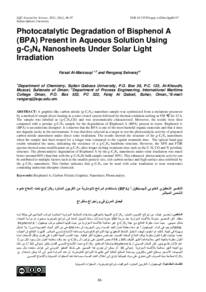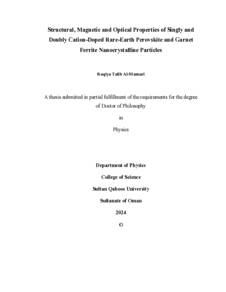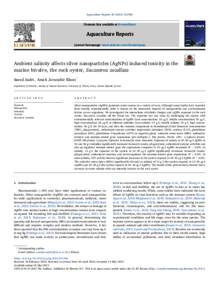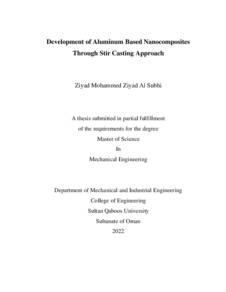Document
Photocatalytic degradation of bisphenol a (BPA) present in aqueous solution using g-C3N4 nanosheets under solar light irradiation.
Identifier
DOI:10.53539/squjs.vol26iss2pp86-97
Source
Sultan Qaboos University Journal for Scientific. v. 26, no. 2, p. 86-97.
Contributors
Selvaraj, Rengaraj., Author
Other titles
التكسير التحفيزي الضوئي للبيسينفول أ (BPA) استخدام شرائح نانومترية من الكربون المنترد g-C3N4 تحت اشعاع ضوء الشمس المباشر.
Country
Oman
City
Muscat.
Publisher
College of Science, Sultan Qaboos University.
Gregorian
2021-12-26
Language
English
Subject
English abstract
A graphite-like carbon nitride (g-C3N4) nanosheet sample was synthesized from a melamine precursor by a method of simple direct heating in a semi-closed system followed by thermal oxidation etching at 550 °C for 12 h. The sample was labelled as (g-C3N412h) and was systematically characterized. Moreover, the results were then compared with a pristine g-C3N4 sample for the degradation of Bisphenol A (BPA) present in water. Bisphenol A (BPA) is an endocrine disruptor. It is known that the BPA is one of the most harmful organic materials and that it does not degrade easily in the environment. It was therefore selected as a target to test the photocatalytic activity of prepared carbon nitride nanosheets under direct solar irradiation. The results showed the structure of the g-C3N4 nanosheets when the sample had been treated for a longer time compared to the regular treatment time. The optical band gap results remained the same, indicating the existence of a g-C3N4 backbone structure. However, the XPS and FTIR spectra showed some modification on g-C3N4 after longer etching treatment time such as the C-H, CO and N pyridinic structure. The photocatalytic degradation of Bisphenol A by the g-C3N4 nanosheets under solar irradiation was much better (around 60%) than that with the g-C3N43h bulk sample (around 30%). This enhanced photocatalytic activity can be attributed to multiple factors such as the smaller particle size, rich carbon surface and high surface area exhibited by the g-C3N4 nanosheets. This further indicates that g-C3N4 can be used with solar irradiation to treat wastewater containing endocrine disruptor chemicals.
ISSN
2414-536X
Arabic abstract
تم تصنيع عينة من ورقة نانوية تشبه نيتريد الكربون (g-C3N4) من مادة الميلامين عن طريق التسخين المباشر البسيط في نظام شبه مغلق يتبعه حفر الأكسدة الحرارية عند 550 درجة مئوية لمدة 12 ساعة. تم تصنيف العينة على أنها (g-C3N412h) وتم توصيفها بشكل منهجي. علاوة على ذلك، تمت مقارنة النتائج بعد ذلك بعينة g-C3N4 الأصلية لتحلل البيسفينول A (BPA) الموجود في الماء. البيسفينول أ (BPA) هو مسبب لاختلال الغدد الصماء. ومن المعروف أن مادة BPA هي من أكثر المواد العضوية ضرراً وأنها لا تتحلل بسهولة في البيئة. لذلك تم اختياره كهدف لاختبار نشاط التحفيز الضوئي لأوراق نيتريد الكربون النانوية المحضرة تحت إشعاع شمسي مباشر. وأظهرت النتائج بنية أوراق النانو g-C3N4 عندما تمت معالجة العينة لفترة أطول مقارنة بوقت المعالجة العادي. ظلت نتائج فجوة النطاق البصري كما هي، مما يشير إلى وجود هيكل العمود الفقري g-C3N4. ومع ذلك، أظهر أطياف XPS وFTIR بعض التعديل على g-C3N4 بعد وقت معالجة أطول للحفر مثل البنية البيريدينية CH وCO وN. كان التحلل الضوئي للبيسفينول A بواسطة صفائح النانو g-C3N4 تحت الإشعاع الشمسي أفضل بكثير (حوالي 60٪) من العينة السائبة g-C3N43h (حوالي 30٪). يمكن أن يُعزى نشاط التحفيز الضوئي المعزز هذا إلى عوامل متعددة مثل حجم الجسيمات الأصغر وسطح الكربون الغني ومساحة السطح العالية التي تظهرها صفائح النانو g-C3N4. يشير هذا أيضًا إلى أنه يمكن استخدام g-C3N4 مع الإشعاع الشمسي لمعالجة مياه الصرف الصحي التي تحتوي على مواد كيميائية اختلال الغدد الصماء.
Category
Journal articles




